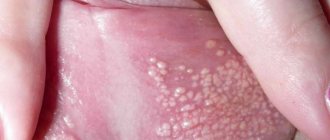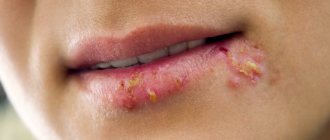The external genitalia of a woman have a thin folded structure. This is due to the protective mechanisms necessary to prevent infection. However, there are situations in which one or more lumps are found on the labia or surrounding tissues. There can be many reasons for this, and not all of them are harmless. Almost all pathologies are accompanied by burning, itching, pain, swelling and heat (due to the inflammatory process). Here it is better not to wait for complications to develop and seek help from a surgeon.
Inflamed hair follicle
The appearance of a ball on a woman’s labia may be associated with the occurrence of a boil (inflammation of the hair follicle). The intimate area has a large number of hairs. Wearing uncomfortable underwear, damaging the protective layer of the skin during depilation and hair removal, and discharge from the genital tract create a favorable environment for the proliferation of pathogenic microorganisms inside the follicle.
As a result, a ball with whitish contents and a purulent core is formed. The disease is characterized by painful compaction, a red edging around the affected area, and absence of itching. Treatment should begin immediately by treating the affected area with an antiseptic and applying an antibacterial ointment (for example, Levomekol). If symptoms increase and swelling of the surrounding tissues develops, you should consult a surgeon to open the abscess surgically.
Temporary seals
When wearing underwear that is too tight, a pimple may appear, which in appearance resembles a wen or a lump caused by bartholinitis, but after eliminating the traumatic factor, the pimple goes away.
Sometimes acne occurs due to contact with dirty hands or the use of products to which an individual allergic reaction is detected.
Temporary formation of a lump occurs after hypothermia or a cold, but after recovery it disappears.
Inflammation of the Bartholin gland
The Bartholin gland is a paired exocrine gland, which is located in the thickness of the labia majora and is designed to secrete secretions that maintain normal moisture of the mucous membranes. It can become inflamed for a number of reasons:
- improper hygiene;
- decreased immunity;
- traumatic injury due to tight underwear;
- inflammatory process in neighboring tissues.
As a result, a painful ball forms on the labia, which can reach several centimeters in diameter. The compaction causes discomfort when walking due to its large volume and pronounced inflammation. At the initial stage, a pea-sized ball can be felt (most often on the labia minora). A burning sensation and increased temperature are felt in the same place. A complication is the formation of a cyst or abscess at the site of the lesion, which can only be treated surgically.
Swelling of the penis and testicles.
Swelling of the genital organs can be caused by both completely harmless factors (passionate sex, tight underwear, allergies, poor hygiene) and serious reasons. Therefore, if the swelling does not subside within a day or additional symptoms appear (itching, burning, redness, discharge, rash, inability to open the foreskin), you should consult a specialist.
Why does the penis and/or testicles swell?
Various reasons can cause swelling of the penis and testicles:
Balanitis, posthitis, balanoposthitis.
Balanitis (inflammatory disease of the head of the penis) and posthitis (inflammatory process of the foreskin) are usually inseparable, which is why they are combined under the common term “balanoposthitis.” In a man, erosions form on the head of the penis and in the area of the foreskin, pain, swelling, and hardening of the inguinal lymph nodes are possible.
Cavernite.
Pathological processes in the cavernous bodies cause swelling of the shaft of the penis.
Phimosis.
Due to the narrowing of the foreskin, the head of the penis is not fully released, which leads to inflammation and swelling.
Paraphimosis.
Pinching the head of the penis by the foreskin causes redness and swelling of the organ, and pain when urinating. In the absence of timely medical care, tissue necrosis is possible.
Thrombophlebitis.
As a result of inflammation of the dorsal vein, the penis swells and the temperature rises sharply. Physical activity and movement cause pain.
Allergy.
Itching and swelling of the penis can be caused by synthetic underwear, poor-quality lubricants, condoms, and long-term use of antibiotics.
Microtraumas.
The slightest bruise can provoke swelling of the penis and the appearance of a hematoma, which is explained by the increased sensitivity of the organ. Sometimes the cause of microtrauma can be a strong impact on the penis during sexual intercourse or masturbation, or wearing too tight underwear.
Infections.
Sexually transmitted diseases (trichomoniasis, chlamydia, gonorrhea, syphilis) often cause swelling of the genital organs. With syphilis, a growing compaction also becomes noticeable, and the general condition worsens. Swelling of the penis is also possible with systemic infections (tuberculosis).
Tumor.
The cause of swelling can be a malignant neoplasm, but swelling of the entire trunk is extremely rare.
Thrush
A disease caused by pathological reproduction of the fungus of the genus Candida. Infection occurs through sexual contact, although transmission of the pathogen from mother to child can also occur. The acute course is manifested by copious curdled discharge, a white coating and pronounced itching. In the absence of adequate treatment, over time it can become chronic, which is characterized by the appearance of small swollen whitish tubercles on the mucous membrane of the perineum and a rash on the labia. Treatment of the disease should be carried out comprehensively, including the following points:
- antifungal therapy to combat the causative agent of the disease;
- measures aimed at increasing the body's immune defense;
- normalization of vaginal microflora (lacto- and bifidobacteria, lactic acid).
A timely visit to a doctor will help get rid of thrush in 5-10 days.
Time to go to the doctor
If all diseases were treated with proper hygiene... There are clinical manifestations that require immediate consultation with a specialist:
- painful condition of the perineum;
- discharge (white, cloudy);
- mobility of seals;
- accelerated growth in education;
- itching and burning.
The first specialist you need to contact is a gynecologist. His task is to sweep away sexually transmitted diseases.
Despite widespread educational work on the prevention of sexually transmitted diseases, 10% of the world's population are infected with them every year. In Russia, every third woman out of four manages to get an STD by the time of pregnancy. If chlamydia, trichomoniasis, and gonorrhea are not treated in a timely manner, there is a high risk of infertility.
Therefore, if you are embarrassed to go to a antenatal clinic, find a medical center, anonymously conduct an examination, and then be sure to visit a gynecologist. Self-medication for STIs does not work.
Herpes genital
The disease is caused by herpes virus type 2 (the second name is genital). The resulting balls are of soft consistency and small in size. Often grouped together and filled with watery contents. They cause significant discomfort and can manifest as severe, unbearable vaginal itching. When scratching the affected area, small ulcers form, and the infection spreads to adjacent tissues.
The rashes disappear about a month after the first blisters appear. Even with adequate treatment, the pathology can recur, causing serious discomfort to the woman. It is transmitted sexually, so treatment of both partners is considered mandatory.
Photo of balls on the labia
Syphilitic chancre
Syphilitic chancre is the primary sign of the development of syphilis. Infection occurs through sexual contact, although contact also occurs. Initially, chancre looks like an area of redness on the skin or mucous membrane. As it develops, it is separated from healthy tissues by compaction along the periphery with the formation of a hard bottom. It may appear as a pea-sized ball on the labia. Its size most often does not exceed 1 cm, but in rare cases two-centimeter chancres are also found.
It does not cause discomfort to the woman and proceeds without itching, burning or pain. This is often the reason for the detection of the disease in late stages, when a number of other symptoms are added. The disease is treated at the first or second stage with antibacterial therapy for three weeks; it rarely becomes chronic.
Oncology
The most unfavorable option is tumors under the skin in the intimate area. According to statistics, vulvar cancer is rare, on average 2-3 cases per 100 thousand, but no one wants to fall into these meager percentages. Elderly women are more often affected. In 90% of cases, the disease causes squamous cell carcinoma and is accompanied by typical gynecological syndromes: itching, burning, neoplasms that constantly grow. If left untreated, bleeding and painful ulcers form.
Many ladies are embarrassed to consult a doctor when they discover lumps inside the labia. Almost 50% of patients are seen when vulvar cancer is observed at stages III-IV, which complicates recovery.
To exclude synchronicity of internal neoplasia, it is necessary to conduct an examination of the vagina and cervix, perform a biopsy, and morphological examination of a tumor biopsy at the first symptoms. Recovery depends on many factors (size and thickness of the formation, presence/absence of metastases, degree of damage to the external and internal genital organs).
Benign neoplasms
Benign diseases are not seriously life-threatening, but can cause serious discomfort. Possible causes of a ball on the clitoris, labia and perineum include:
- Lipoma. Neoplasm from adipose tissue. It has a capsule that separates it from surrounding tissues. It can be felt as a soft, moving ball on the labia majora (less often the labia minora). The main reason for the development is the increased tendency of the skin to secrete fat in combination with hormonal imbalance.
- Atheroma. It is a cyst of epidermal tissue, the cavity of which is filled with fatty secretion. Develops when the main duct of the sebaceous gland is blocked. A characteristic feature is a black dot in the middle of the compaction.
- Fibroma. A tumor from the submucosal layer of the vagina, consisting of collagen fibers. The consistency ranges from soft to very dense formation.
- Myoma. A tumor of muscle tissue located in the labia majora. Characterized by slow growth.
- Hemangioma. A neoplasm developing from vascular tissue. It is characterized by the most aggressive growth among all benign tumors. It is more common in childhood and manifests itself as a hard ball on the labia minora.
- Hidradenoma. Tumor of sweat glands. It has small sizes (up to 1 cm) and a low growth rate. Color can vary from light yellow to bright pink.
All benign tumors are surgically removed and sent for histological examination. Its purpose is to determine the tissue identity of the tumor and exclude a malignant process.
Malignant neoplasms
The main oncological disease affecting the external genitalia in women is vulvar cancer. Occurs more often in the postmenopausal period. It is detected late, as in the first stages it does not cause any discomfort.
Additional symptoms with the development of pathology are itching at the site of the lesion and pathological discharge mixed with blood. The disease is a life-threatening condition. Treatment includes surgery, radiation and chemotherapy.
Conclusion: Diseases, the symptom of which is a lump on the genitals, most often do not pose a serious threat to the life and health of the patient. However, in any case, it is necessary to consult a gynecologist to diagnose the formation and decide on its treatment.
Bartholinitis
Bartholinitis is understood as a disease that manifests itself as a thickening under the labia closer to the vagina. The formation can be the size of a pea, but if left untreated it reaches the size of a chicken egg. Diagnosed visually during a gynecological examination. The main cause is a blockage of the Bartholin glands located near the back of the labia majora.
This happens due to the fact that microorganisms enter the ducts, and a favorable environment contributes to their rapid growth. A ball-shaped seal on the lips is felt 5 days after the start of the process and is accompanied by tingling and burning. Timely treatment takes place without complications, but if you do not pay attention to this, the disease will lead to the appearance of a cyst.
Factors contributing to bartholinitis:
- weakened immune system;
- diseases of the genitourinary system;
- diabetes;
- poor nutrition;
- antibiotics.
Bartholinitis is also caused by sexually transmitted infections. Purulent bartholinitis is especially severe. Gonorrhea disease mostly manifests itself in women after 2-3 days of the latent period with a feeling of tickling, itching in the genitals, which turns into pain when walking.
After another 2-3 days, the disease spreads to the cervix and descends to the area of the Bartholin glands. The tissue around the Bartholin glands turns red, gland abscesses form, turning into thickenings. A small ball quickly develops into a tumor. Gonorrheal infection affects the entire intimate area, the cervix, leading to endometritis and sepsis.
There is only one way to prevent gonorrheal bartholinitis – the absence of promiscuity. The infection is not only transmitted through sexual contact; infection occurs through beds, shared towels, and is transmitted to children.
If you feel a lump on your outer lips, accompanied by itching and a rise in temperature, you should immediately go to the hospital.











